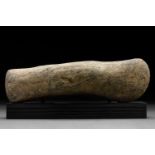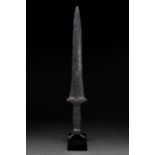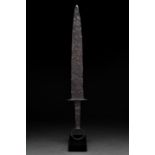Verfeinern Sie Ihre Suche
Schätzpreis
Kategorie
- Arms, Armour & Militaria (108)
- Greek, Roman, Egyptian & Other Antiquities (68)
- Jewellery (41)
- Sculpture (35)
- Chinese Works of Art (32)
- Glassware (11)
- Ceramics (5)
- Coins (5)
- Collectables (4)
- Porcelain (4)
- Islamic Works of Art (3)
- Stamps (3)
- Books & Periodicals (2)
- Metalware (2)
- Scientific Instruments (2)
- Taxidermy & Natural History (2)
- Kitchenalia (1)
- Textiles (1)
- Vintage Fashion (1)
- Liste
- Galerie
Ein Abonnement der Preisliste ist notwendig um Ergebnisse, von Auktionen die vor einem längeren Zeitraum als 10 Tagen stattgefunden haben, ansehen zu können. Klicken Sie hier für mehr Informationen
MEDIEVAL IRON AXE HEAD
Ca. 1400-1600 AD. Eurooean. An iron bearded axe head with a slender and long curved blade and a reinforced poll that may be used as a hammer. The ...
Ca. 900–1100 AD. Viking Age. An iron bearded axe head with a curved blade, a reinforced square poll and a long cheek decorated with geometric inci...
Ca. 1000–1200 AD. Viking Age. An iron bearded axe head with swept upper face to the gently curved blade, a socket with lateral wings above and bel...
Ca. 900–1100 AD. Viking Age. An iron axehead with a triangular cheek, a slender curved blade, and rectangular panels extending below the socket. G...
Ca. 1200–700 BC. Western Asiatic. An attractive ceremonial axe head with a slender blade curving downward and cylindrical shaft tube. On the back ...
Ca. 1200–700 BC. Western Asiatic. Cast axe head comprising of a tubular socket and a shaft with cylindrical section, enhanced by three horizontal ...
Ca. 1200–700 BC. Western Asiatic. Cast axe head comprising of a tubular socket with ribbed borders, a scroll to the upper edge and bulb below, a c...
Ca. 1200–700 BC. Western Asiatic. An attractive ceremonial axe head with a rectangular blade and wide, cylindrical shaft tube. On the back a solid...
Ca. 1200–700 BC. Western Asiatic. Cast axe head comprising of a tubular socket with ribbed borders, a scroll to the upper edge and bulb below, col...
BRONZE AGE SOCKETED AXE HEAD
Ca. 800–600 BC. European. A hefty cast bronze axe head with a flared blade, blunt sides, a thick neck, and a rounded collar with a hoop. The head ...
Ca. 1200–700 BC. Western Asiatic/Aegean. A bronze spearhead with an elongated leaf-shaped blade and barbs, wide raised midrib, and a short socket ...
Ca. 1200–700 BC. Western Asiatic/Aegean. A bronze spear with an elongated leaf-shaped blade, raised midrib, sharpened edges that taper gradually t...
Ca. 1200–700 BC. Western Asiatic/Aegean. A bronze spearhead with an elongated leaf-shaped blade and barbs, wide raised midrib, and a short socket ...
Ca. 1000–1200 AD. Viking Age. An iron spearhead with a leaf-shaped blade, sharp edges flaring halfway through the blade before tapering to a point...
ROMAN IRON SOCKETED SPEARHEAD
Ca. 300–500 AD Roman. An iron spearhead comprising a slender tapering leaf-shaped blade with a raised midrib and a long, flared socket for increas...
ROMAN IRON SOCKETED SPEARHEAD
Ca. 300–500 AD Roman. A spearhead comprising a slender tapering leaf-shaped blade with a narrow neck and conical socket for increased control. Wea...
VIKING ERA IRON SOCKETED SPEAR
Ca. 800–1110 AD. Viking Age. An iron spearhead with lanceolate blade with flaring shoulders and a long, circular socket. Spears were an important ...
ROMAN IRON SPEARHEAD
Ca. 100–300 AD. Roman. An iron spearhead with an elongated leaf-shaped blade, sharp tapering edges, and a long flared socket. Good condition; cust...
ROMAN IRON SPEARHEAD
Ca. 100–300 AD. Roman. An iron spearhead with an elongated leaf-shaped blade, sharp tapering edges, and a long flared socket. Good condition; cust...
ROMAN IRON SPEARHEAD
Ca. 100–300 AD. Roman. An iron spearhead with an elongated leaf-shaped blade with a raised central ridge, sharp tapering edges, and a long flared ...
Ca. 900–1100 AD. Byzantine. A “Greek fire” grenade comprising a domed lid, a pointed base, and a globular body decorated with six vertical bands o...
Ca. 900–1100 AD. Byzantine. A “Greek fire” grenade comprising a globular body, domed lid and a pointed base. The body is decorated with raised tea...
Ca. 900–1100 AD. Byzantine. A “Greek fire” grenade comprising an acorn-shaped body, domed lid, and a pointed base. The upper registry of the body ...
Ca. Late 3000–Early 1000 BC. A large and finely polished fish-shaped axe in light beige stone, with an asymmetric convex cutting edge tapering to ...
NEOLITHIC STONE AXE HEAD
Ca. 5000–3000 BC. Neolithic. A nice boat-shaped pecked and ground axe head with square butt and rectangular in section, the ground socket with exp...
NEOLITHIC STONE AXE HEAD
Ca. 5000–3000 BC. Neolithic. A nice ground axe head with a slightly rounded butt and curved edge, the ground socket with expanding edge has a hole...
BRONZE AGE SICKLE
Ca. 2000–1000 BC. Western/Central Europe. A bronze single-edged sickle blade with a rounded tip and a short handle to the end. Sickle blades were ...
BRONZE AGE SICKLE
Ca. 2000–1000 BC. Western/Central Europe. A bronze single-edged sickle blade with a rounded tip. Sickle blades were used for utilitarian and agrar...
ANCIENT BRONZE MACE HEAD
Ca. 1200–700 BC. Western Asiatic. A fine example of a cast bronze mace head with a flat tip, the cylindrical body- probably placed around a wooden...
ANCIENT BRONZE SPIKED MACE HEAD
Ca. 1200–700 BC. Western Asiatic. A fine example of a cast bronze mace head with a flat tip, the cylindrical body- probably placed around a wooden...
Ca. 900–1100 AD. A Medieval iron mace head attached to a long chain. Provenance: Private Oxfordshire collection; Formerly acquired on the European...
ca. 1300 AD. Nice Medieval European sword with handle; well preserved blade and crossguard. The item was studied by Russel Scott; famous lecturer,...
Ca. 100–300 AD. Roman. An iron pilum spearhead with a barbed, triangular blade, and a long, narrow neck, and a robust flaring socket. Good conditi...
MEDIEVAL EUROPEAN LANCEHAD
Ca. 1400 AD. European. An iron lancehead with narrow lozenge-section blade, conical socket with collar to the neck. The Lance was a formidable wea...
VIKING IRON SWORD - FULL REPORT
Ca. 700-1000 AD. Viking age. An iron sword with ad doubled-edged blade, broken off from the half and a wide, broad, tapering guard and circular po...
Ca. 600–400 BC. Scythian / Hellenistic. A well preserved short iron sword of the akinakes type (Greek ????????') with a pointed blade, bow-shaped ...
Ca. 600–400 BC. Scythian / Hellenistic. A well preserved short iron sword of the akinakes type (Greek ????????') with a pointed bevelled blade, fl...
Ca. 1100–900 BC. Aegean. A bronze Troy-type sword blade, leaf-shaped in plan with curved lateral extensions to the shoulder; the midrib extends to...
ANCIENT BRONZE SWORD
Ca. 1200–700 BC. Western Asiatic/Aegean. A bronze sword with an elongated leaf-shaped blade, raised midrib, and short tang for insertion into a hi...
ANCIENT BRONZE SWORD
Ca. 1200–700 BC. Western Asiatic/Aegean. A bronze sword with an elongated leaf-shaped blade, raised midrib, and short tang for insertion into a hi...
ANCIENT BRONZE SWORD
Ca. 1200–700 BC. Western Asiatic/Aegean. A bronze sword with an elongated leaf-shaped blade, raised midrib, and short tang for insertion into a hi...
VIKING IRON BATTLE AXE
Ca. 1000–1200 AD. Viking Age. An iron axe head with long flaring cheek and curved blade; reinforced socket eye with a flared poll. The era known a...
Ca. 900–1100 AD. A bearded iron axe head comprising a broad, curved cutting blade, a reinforced eye, and a flat hammerhead on the rear. Bearded ax...
VIKING IRON BATTLE AXE
Ca. 900–1100 AD. Viking Age. An iron battle axe with a narrow, crescentic blade, tapering cheek, reinforced poll and socket. The era known as the ...
Ca. 900–1100 AD. Viking Age. An iron bearded axe head with a slender and long curved blade and reinforced poll that may have been used as a hammer...
Ca. 900–1100 AD. Viking Age. An iron bearded axe head with a short curved blade and a reinforced poll. The profile of the blade is square at the l...
Ca. 900–1100 AD. Viking age. An iron bearded axe head with a heavy blade with a triangular-section cheek and curved lower profile, a rounded socke...
Ca. 900–1100 AD. Viking age. An iron bearded axe head with a heavy blade with a triangular-section cheek and curved lower profile, a rounded socke...
ANCIENT BRONZE LABRYS VOTIVE AXE
Ca. 1200–700 BC. Western Asiatic. A beautiful two-bladed axe head of the labrys type. Custom made stand included. Provenance: Private Oxfordshire ...
ANCIENT BRONZE SOCKETED AXE HEAD
Ca. 1200–700 BC. Western Asiatic. A bronze axe head with a curved blade, triangular cheek and a heavy, circular socket. Bronze weaponry production...
EARLY BRONZE AGE FLAT AXE
Ca. 900–700 BC. Koban-Caucasian Culture. A beautiful bronze flat axe, with a crescentic blade and a long butt. Excellent condition. The Koban cult...
ANCIENT BRONZE SOCKETED AXE HEAD
Ca. 1200–700 BC. Western Asiatic. A bronze axe head with a curved blade, triangular cheek, slightly visible horizontal collars stretching from the...
ANCIENT BRONZE SOCKETED AXE HEAD
Ca. 1200–700 BC. Western Asiatic. Cast axe head comprising of a tubular socket with ribbed borders, a scroll to the upper edge and bulb below, a c...
ANCIENT BRONZE LABRYS VOTIVE AXE
Ca. 1200–700 BC. Western Asiatic. A beautiful two-bladed axe head of the labrys type. Bronze weaponry production flourished from the 2nd millenniu...
EARLY BRONZE AGE FLAT AXE
Ca. 900–700 BC. Koban-Caucasian Culture. A beautiful bronze flat axe, with a crescentic blade and a long butt. Excellent condition. The Koban cult...
BRONZE AGE SOCKETED AXE HEAD
Ca. 800–600 BC. European. A hefty cast bronze axe head with a flared blade, blunt sides, a thick neck, and a rounded collar with a hoop. The head ...
EARLY BRONZE AGE FLAT AXE
Ca. 900–700 BC. Koban-Caucasian Culture. A beautiful bronze flat axe, with a crescentic blade and a long butt. Excellent condition. The Koban cult...
BRONZE AGE SOCKETED AXE HEAD
Ca. 800–600 BC. European Bronze Age. An axe head with very fine olive-green patina with wide cheek, tapered blade, and an ovoid axe eye at the bac...
Ca. 1200–700 BC. Western Asiatic/Aegean. A bronze spearhead with an elongated leaf-shaped blade and barbs, wide raised midrib, and a short socket ...
Ca. 1200–700 BC. Western Asiatic/Aegean. A bronze spearhead with an elongated leaf-shaped blade and barbs, wide raised midrib, and a short socket ...





























































